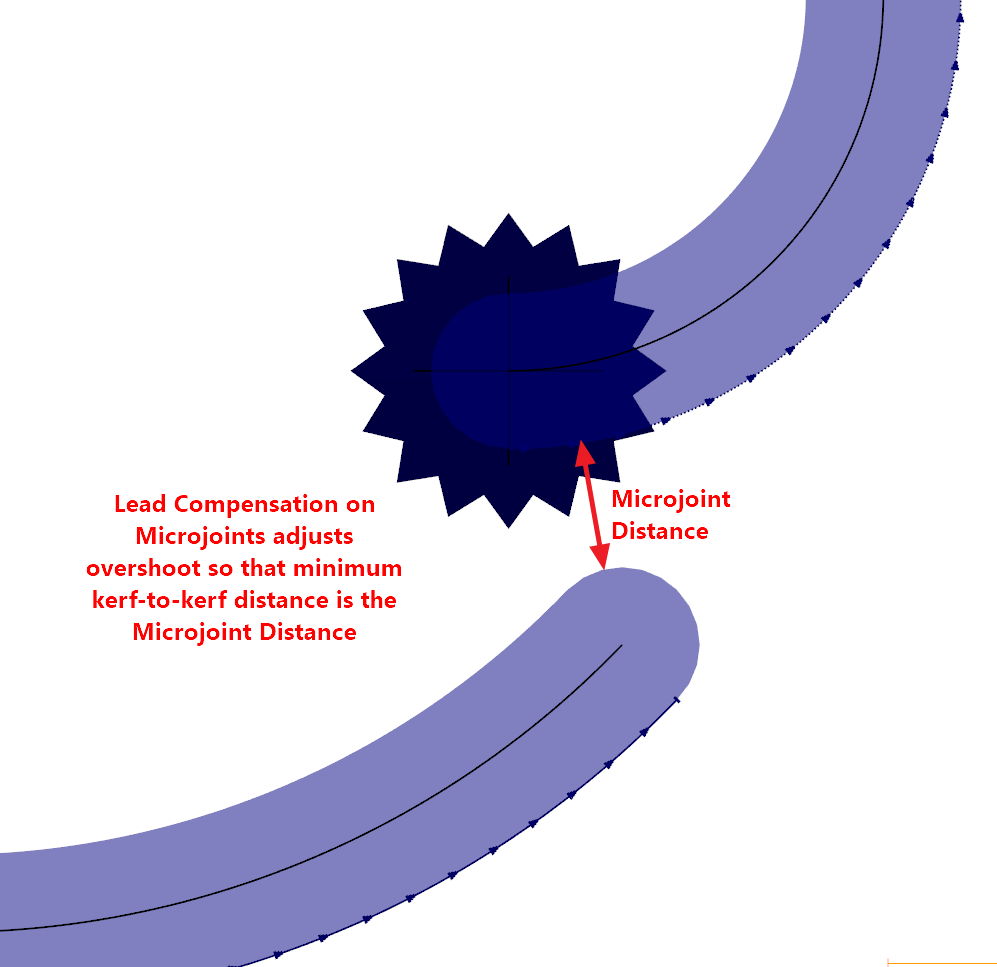Microjoints are small tabs used to hold parts in the plate or sheet from which they are cut, to stop them falling out or tipping; especially used in Laser cutting.
Currently Microjoints are supported on Cutting Tools only.
See also Tagging or Splitting a Cut which allows multiple splits to be added.
A Microjoint is normally formed by stopping a cut short of its start (similar to negative overshoot) and applying no leadout; a similar effect can be created in fact using negative overcut.
Cutting tools have a number of settings for automatic application of Microjoints, as well as a Microjoint Size in process data (per grade and thickness):
Microjoints Active enables or disables automatic microjointing for this tool.
Microjoints Default The default size for microjoints used if the MicroJoint Size in the process data is 0.
Microjoints Lead Compensation changes the calculation of the microjoint size to be from the closest point the leadin comes, taking in account of the kerf of the cut. This is illustrated below:

By default if Microjoints Active above is checked, microjoints are assumed to be applied, however if either of the following filters are active (ie non-zero), they may inhibit microjoints being applied:
Microjoints: Internal Small Path Filter If this is non-zero, the extents of internal paths are checked against it. If both the width and height are less than than this threshold, the microjoint will be inhibited.
Microjoints Large Path Filter If this is non-zero, the extents of all paths are checked against it. If both the width and height are greater than this threshold, the microjoint will be inhibited.
In Process Data there is a Microjoint Size for each grade, thickness, condition and process threshold.
•If this is positive then microjoints of this size will be applied (as long as Microjoints Active is True and the path satisfies the Small Path Filter and Large Path Filter as described above)
•If this is negative then microjoints will not be automatically applied, but if manually applied will use the absolute value of the size.
•If this is 0, then Microjoints Default above will be used.
All of the following must be satisfied for a microjoint to be automatically placed:
1.Microjoints Active for the cutting tool to be True.
2.The contour size must satisfy the Small Path Filter and Large Path Filter if they are nonzero
3.Either Microjoint Size is positive for the looked up process data, or it is 0 and Microjoints Default is positive.
Disabling Microjoints on Internal Cuts
Set the Internal Small Path Filter to a large value, larger than any expected internal cut to be encountered.
When a microjoint of a given size is applied, the overshoot is set to the negative of the Microjoint Size, and the leadout is removed. Thus Microjoint settings override any Tangent Overshoot settings in costing data when Microjointing is in effect.
The Microjoint size is also used as the default gap size when manually splitting a cut.
What is the difference between Tangent Overshoot and Microjoints?
Both refer to settings in Process data and in the Machiones section which control how typically Negative Overcut settings are applied to Cut processes. However they serve different purposes and are applied differently.
Negative Tangent Overshoot is normally used to reduce piece gouging, and sometime to create instead a small nipple on the part at the lead attachment point. The key word here is Tangent, it is only applied when the leads attach at a tangent, for example on the inside of a circular hole. Sometimes positive Tangent Overshoot is used to ensure the lag in the cutting process fully severs the part.
Microjoints use Negative Overcut to keep the part attached to the parent plate. They are applied to ALL leads, ie they cause Negative Overcut even if the leadin attaches at a corner. Microjointing also inhibits any leadout.